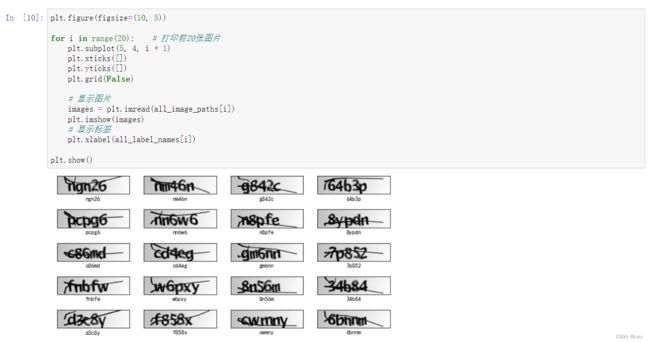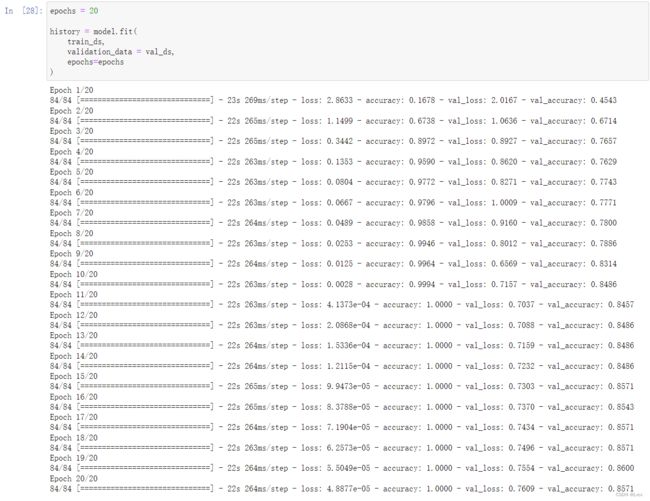深度学习实战04-卷积神经网络(CNN)实现验证码识别
活动地址:CSDN21天学习挑战赛
参考文章:https://mtyjkh.blog.csdn.net/article/details/118211253
一、前期准备
1. 设置GPU
如果没有gpu,可以忽略,直接使用cpu。
import tensorflow as tf
gpus = tf.config.list_physical_devices("GPU")
if gpus:
tf.config.experimental.set_memory_growth(gpus[0], True) # 设置GPU显存按需使用。
tf.config.set_visible_devices([gpus[0]], "GPU")
2. 导入数据
import matplotlib.pyplot as plt
# 设置支持中文显示
plt.rcParams['font.sans-serif'] = ['SimHei'] # 用来正常显示中文标签
plt.rcParams['axes.unicode_minus'] = False # 用来正常显示负号
import os, PIL, random, pathlib
# 设置随机种子尽可能使结果可以重现
import numpy as np
np.random.seed(1)
# 设置随机种子
import tensorflow as tf
tf.random.set_seed(1)
# 数据所在位置
data_dir = "./datasets/captcha"
data_dir = pathlib.Path(data_dir)
all_image_paths = list(data_dir.glob("*"))
all_image_paths = [str(path) for path in all_image_paths]
# 打乱数据
random.shuffle(all_image_paths)
# 获取数据标签
all_label_names = [path.split("\\")[-1].split(".")[0] for path in all_image_paths]
image_count = len(all_image_paths)
print("图片的总数为:", image_count)
3. 数据可视化
plt.figure(figsize=(10, 5))
for i in range(20): # 打印前20张图片
plt.subplot(5, 4, i + 1)
plt.xticks([])
plt.yticks([])
plt.grid(False)
# 显示图片
images = plt.imread(all_image_paths[i])
plt.imshow(images)
# 显示标签
plt.xlabel(all_label_names[i])
plt.show()
4. 标签数字化
number = ['0', '1', '2', '3', '4', '5', '6', '7', '8', '9']
alphabet = ['a', 'b', 'c', 'd', 'e', 'f', 'g', 'h', 'i', 'j', 'k', 'l', 'm', 'n', 'o', 'p', 'q', 'r', 's', 't', 'u', 'v', 'w', 'x', 'y', 'z']
char_set = number + alphabet
char_set_len = len(char_set)
label_name_len = len(all_label_names[0])
# 将字符串数字化
def text2vec(text):
vector = np.zeros([label_name_len, char_set_len])
for i, c in enumerate(text):
idx = char_set.index(c)
vector[i][idx] = 1.0
return vector
all_labels = [text2vec(i) for i in all_label_names]
二、构建一个tf.data.Dataset
1. 预处理函数
def preprocess_image(image):
image = tf.image.decode_jpeg(image, channels=1)
image = tf.image.resize(image, [50, 200])
return image/255.0
def load_and_preprocess_image(path):
image = tf.io.read_file(path)
return preprocess_image(image)
2. 加载数据
构建tf.data.Dataset最简单的方法就是使用from_tensor_slices()方法。
AUTOTUNE = tf.data.experimental.AUTOTUNE
path_ds = tf.data.Dataset.from_tensor_slices(all_image_paths)
image_ds = path_ds.map(load_and_preprocess_image, num_parallel_calls=AUTOTUNE)
label_ds = tf.data.Dataset.from_tensor_slices(all_labels)
image_label_ds = tf.data.Dataset.zip((image_ds, label_ds))
image_label_ds
train_ds = image_label_ds.take(1000) # 前1000个batch
val_ds = image_label_ds.skip(1000) # 跳过前1000个, 选取后面的,后面的只有70个
3. 配置数据
prefetch()功能详细介绍:CPU正在准备数据时,加速器处于空闲状态。相反,当加速器正在训练模型时,CPU处于空闲状态。因此,训练所用的时间是CPU预处理时间和加速器训练时间的总和。prefetch()将训练步骤的预处理和模型执行过程重叠到一起。当加速器正在执行第N个训练步时,CPU正在准备第N+1步的数据。这样做不仅可以最大限度地缩短训练的单步用时(而不是总用时),而且可以缩短提取和转换数据所需的时间。如果不使用prefetch(),CPU和GPU/TPU在大部分时间都处于空闲状态:

BATCH_SIZE = 12
train_ds = train_ds.batch(BATCH_SIZE)
train_ds = train_ds.prefetch(buffer_size=AUTOTUNE)
val_ds = val_ds.batch(BATCH_SIZE)
val_ds = val_ds.prefetch(buffer_size=AUTOTUNE)
val_ds
三、搭建网络模型
from tensorflow.keras import datasets, layers, models
model = models.Sequential([
layers.Conv2D(32, (3, 3), activation='relu', input_shape=(50, 200, 1)), # 卷积层1, 卷积核3*3
layers.MaxPooling2D((2, 2)), # 池化层1, 2*2采样
layers.Conv2D(64, (3, 3), activation='relu'), # 卷积层2,卷积核3*3
layers.MaxPooling2D((2, 2)), # 池化层2, 2*2采样
layers.Flatten(), # Flatten层,连接卷积层和全连接层
layers.Dense(1000, activation='relu'), # 全连接层
layers.Dense(label_name_len * char_set_len),
layers.Reshape([label_name_len, char_set_len]),
layers.Softmax() # 输出层
])
# 打印网络结构
model.summary()
四、编译
model.compile(optimizer="adam",
loss='categorical_crossentropy',
metrics=['accuracy'])
五、训练
epochs = 20
history = model.fit(
train_ds,
validation_data = val_ds,
epochs=epochs
)
六、模型评估
acc = history.history['accuracy']
val_acc = history.history['val_accuracy']
loss = history.history['loss']
val_loss = history.history['val_loss']
epochs_range = range(epochs)
plt.figure(figsize=(12, 4))
plt.subplot(1, 2, 1)
plt.plot(epochs_range, acc, label='Trianing Accuracy')
plt.plot(epochs_range, val_acc, label='Validation Accuracy')
plt.legend(loc='lower right')
plt.title('Training and Validation Accuracy')
plt.subplot(1, 2, 2)
plt.plot(epochs_range, loss, label='Trianing Loss')
plt.plot(epochs_range, val_loss, label='Validation Loss')
plt.legend(loc='upper right')
plt.title('Training and Validation Loss')
plt.show()
七、保存和加载模型
# 保存模型
model.save('model/captcha_model.h5')
# 加载模型
new_model = tf.keras.models.load_model('model/captcha_model.h5')
八、预测
def vec2text(vec):
"""
还原标签(向量->字符串)
"""
text = []
for i, c in enumerate(vec):
text.append(char_set[c])
return "".join(text)
plt.figure(figsize=(10, 8)) # 图形的宽为10高为8
for images, labels in val_ds.take(1):
for i in range(6):
ax = plt.subplot(5, 2, i + 1)
# 显示图片
plt.imshow(images[i])
# 需要给图片增加一个维度
img_array = tf.expand_dims(images[i], 0)
# 使用模型预测验证码
predictions = model.predict(img_array)
plt.title(vec2text(np.argmax(predictions, axis=2)[0]))
plt.axis("off")
在这里插入图片描述







